The medieval spice trade played a pivotal role in shaping global cuisine and food culture. This intricate network of exploration, discovery, and trade routes led to the introduction of new and exotic flavors that revolutionized the way people cooked and ate. From the Far East to the Western World, spices such as pepper, cinnamon, cardamom, and ginger traveled great distances, symbolizing adventure, wealth, and power. This topic cluster delves into the fascinating history of the medieval spice trade and its influence on global cuisine, with a focus on the exploration and discovery of new foods throughout history.
The Medieval Spice Trade: A Gateway to Exploration
During the medieval period, the spice trade flourished as merchants and explorers sought to acquire coveted spices from distant lands. The demand for these precious commodities not only drove trade and commerce but also prompted ambitious expeditions around the world. Explorers like Marco Polo, Christopher Columbus, and Vasco da Gama set sail in search of new trade routes and sources of exotic spices, leading to the discovery of unknown lands, cultures, and culinary treasures.
The quest for spices was not only driven by the desire for culinary delights but also by their perceived medicinal and preservative properties. Spices were highly valued for their ability to enhance the flavors of food, mask odors, and preserve perishable goods in an era before refrigeration. As a result, spices became a symbol of luxury and status, with the demand for them fueling innovation and inspiring great feats of exploration and navigation.
Expanding Palates: The Impact of New Foods
The introduction of new foods through the medieval spice trade had a profound impact on global cuisine, marking the beginning of a culinary exchange that transcended geographic and cultural boundaries. The integration of spices and exotic ingredients into traditional recipes transformed local cuisines and created a rich tapestry of flavors and techniques.
For example, the Arab traders brought cinnamon and cloves from the Far East to Europe, revolutionizing the taste of medieval European dishes. Similarly, the Portuguese exploration of the spice-rich islands of Indonesia and the Indian subcontinent introduced a variety of flavorful ingredients to European palates, forever altering the culinary landscape.
Global Fusion: The Evolution of Food Culture
The fusion of culinary traditions spurred by the medieval spice trade laid the foundation for what we now recognize as global cuisine. The exchange of ingredients, cooking methods, and flavors from around the world resulted in a dynamic blending of food cultures, giving rise to new dishes that reflected the diverse influences of different regions.
Centuries of exploration, discovery, and trade have shaped the way we perceive and appreciate food, creating a global food culture that celebrates diversity and innovation. Today, we can trace the origins of beloved dishes and ingredients back to the medieval spice trade, underscoring the enduring impact of these early encounters with new foods.
Exploring New Frontiers: The Legacy of the Spice Trade
The legacy of the medieval spice trade continues to inspire culinary exploration and discovery in the modern world. From the introduction of novel spices to the cultivation of exotic produce, the pursuit of new flavors echoes the spirit of adventure and curiosity that drove explorers of the past. As we continue to uncover and appreciate the rich history of food and its global connections, we honor the legacy of the medieval spice trade and its enduring influence on the evolution of global cuisine.

